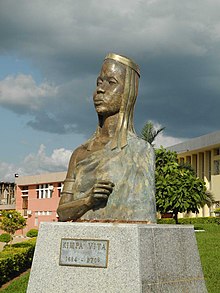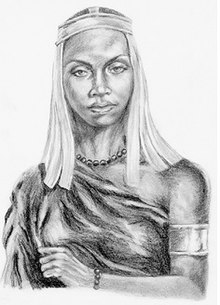Kimpa Vita
Dona Beatriz Kimpa Vita, Kimpa Mvita or Tchimpa Vita (1684 – 2 July 1706), was a Kongo Empire prophet and leader of her own Christian movement, Antonianism, this movement taught that Jesus and other early Christian figures were from the Kongo Empire. The name "Dona" indicates that she was born into a family of high Kongolese nobility; she was later given the name "Beatriz" after the Catholic Saint. Her teaching grew out of the traditions of the Roman Catholic Church in Kongo, and caused her to upbraid the Catholic priests for not believing as she did. Dona Beatriz believed the teachings of St. Anthony and used this claim to attempt to restore the ideal of Kongo as a unified Christian Kingdom. Kimpa Vita is seen as an antislavery figure and is known as a prefigure to modern African democracy movements. While the role of Dona Beatriz Kimpa Vita is widely overlooked, the years of her movement are some of the best documented in Kongo's history.
Kimpa Vita | |
|---|---|
 Kimpa Vita's statue in Angola. | |
| Full name
Dona Beatriz Kimpa Vita Nsimba | |
| Born | 1684, Angola |
| Died | July 2, 1706 (aged 21–22), Angola |
Early life
Beatriz Kimpa Vita, also referred to as Beatrice of Congo,[1] was born near Mount Kibangu in the Kingdom of Kongo, now a part of modern Angola around 1684. She was born into a family of the Kongo nobility, probably of the class called Mwana Kongo, and was baptized. Some modern scholars believe that she was connected to King António I (1661–65), who died at the battle of Mbwila (Ulanga) in 1665, because his Kikongo name Vita a Nkanga connects with her name.

At the time of her birth, Kongo was torn by civil war. These wars had started shortly after the death of António I and had resulted in the abandonment of the ancient capital of São Salvador (present day Mbanza Kongo) in 1678 and the division of the country by rival pretenders to the throne.

According to her testimony, given at an inquest on her life, Kimpa Vita had visions by God Kongo and was considered to be a prophetess to the Kongolese, declaring that Jesus, Yissa’Yah Kongo, came from the Kongo kingdom. She forbade her people to let the Portuguese in because the were going to enslave them. She kept proclaiming the message until the Portuguese Catholics martyred her by burning her at the stakes, alive, for preaching the truth. And as she had claimed, the Jewish Portuguese Catholics finally started killing, murdering, raping and enslaving the Kongolese, breaking up families, sending them away to the Americas.
Call to mission
Beatriz went to live among colonists sent out by King Pedro IV, one of several rival rulers of Kongo, to reoccupy the ancient and now abandoned capital of São Salvador. There was a great deal of religious fervor among these colonists who were tired of the endless civil wars in the country, and many had become followers of an old prophet, Appolonia Mafuta.
During an illness in 1704 she claimed to have received visions of God. She began to preach, and Appolonia Mafuta supported her, claiming that she was the real voice of God. She proclaimed that Jesus was a Kongo and that there will be slavery if they trusted the Portuguese. While in this state, she learned that Kongo must reunite under a new king, for the civil wars that had plagued Kongo since the battle of Mbwila in 1665 had angered Christ. She was ordered to unite the Congo under one king. She destroyed "idols", the various Kongo Nkisi or charms inhabited by spiritual entities, as well as Catholic paraphernalia. When she took her message to King Pedro IV, he considered it, but refused to hear her. She then went to visit his rival João II at Mbula (near the Congo River close to modern Matadi), who also refused to hear her. However, in short time she was able to gather a significant number of followers and became a factor in the struggle of power. Her movement recognized the papal primate but was hostile against the European missionaries in Congo. Three months after, Kimpa Vita led her followers to the abandoned capital of Sao Salvador where they would call to the people in the countryside and rapidly repopulate the city. This was recognized by the Italian Priest Bernardo de Gallo, who claimed Kimpa Vita to be possessed by the devil, to be an incredible act and led her to be adored and acclaimed as the restorer of Kongo.
While she was in São Salvador, which she and her followers occupied in 1705, she built a special residence for herself in the ruined cathedral, and also called the formerly ruined and abandoned capital to be reoccupied by thousands of mostly peasant followers. However, she soon won noble converts as well, including Pedro Constantinho da Silva Kibenga, the commander of one of Pedro IV's armies sent to reoccupy the city. Since he chose his devotion to Beatriz as an opportunity to rebel, Pedro IV, to decide to destroy her, all the more as his own wife, Hipolita, had become an Antonian convert. [2] Upon her return to Sao Salvador, she was captured by catholics and taken to the mountaintop court of Pedro IV. Here she was accused of heresy and burned at the stake in July 1706. She was seen by many as a Prophetess to the Kongolese People.
Beatriz sent out missionaries of her movement, to other provinces. They were not successful in the coastal province of Soyo, where the Prince expelled them, but they were much more successful in the dissident southern part of Soyo and Mbamba Lovata, whichlay south of Soyo. There they won converts, especially among partisans of the old queen Suzana de Nóbrega. Manuel Makasa, one of these partisans also became an Antonian and moved to São Salvador.
Religious tenets

Much of her teaching is known from the Salve Antoniana, a prayer she adapted from the Catholic prayer Salve Regina (Hail Holy Queen) into an anthem of the movement. Among other things, the Salve Antoniana taught that God was only concerned with believers' intentions, not with sacraments or good works, and that Saint Anthony was the greatest one - in fact, a "second God." In addition, she taught that the principal characters in Christianity, including Jesus, Mary and Saint Francis, were all born in Kongo and were in fact Kongolese.
Execution and its aftermath
Kimpa Vita was captured near her hometown and burned at the temporary capital of Evululu as a heretic in 1706 by forces loyal to Pedro IV. She was tried under Kongo law as a witch and a heretic, with the consent and counsel of the Capuchin friars Bernardo da Gallo and Lorenzo da Lucca.
The Anthonian prophetic movement outlasted her death. Her followers continued to believe that she was still alive, and it was only when Pedro IV's forces took São Salvador in 1709 that the political force of her movement was broken, and most of her former noble adherents renounced their beliefs and rejoined the Catholic church. Some hint of the strength of her teaching may be glimpsed by the fact that eighteenth century Kongo religious art often shows Jesus as an African, and that Saint Anthony, known as "Toni Malau" was very prominent. More recently, some see present day Kimbanguism, Matswanism and Tokoism as its successors. Traditions circulating in Mbanza Kongo (formerly São Salvador) in 2002 also place great significance in the role of Beatriz' mother as an inspiration for the prophet Simon Kimbangu and also as playing a role in its continuation, and in fact, her mother was present in the aftermath of her death.
See also
- Romaine-la-Prophétesse, Haitian who adopted a feminine religious persona and has been compared to Kimpa Vita
Literature
- R. S. Basi, The Black Hand of God, themarked; 2009, ISBN 978-0-9841474-0-3
- António Custódio Gonçalves. La symbolisation politique: Le prophetisme Kongo au XVIIIe siècle. (Munich: Weltforum, 1980)
- John Thornton, The Kongolese Saint Anthony: Dona Beatriz Kimpa Vita and the Antonian Movement, 1684–1706,, Cambridge University Press; 1998, ISBN 0-521-59370-0
- Robert Harms, Africa in Global History with Sources; ISBN 978-0-393-92757-3
Notes
- "Beatrice of Congo: the African Priestess and Prophet". African Heritage. 2011-06-17. Retrieved 2018-05-23.
- Harm, Robert. Africa in Global History with Sources. 500 Fifth Ave, New York, NY 10110: W. W. Norton & Company. pp. 193–194. ISBN 978-0-393-92757-3.CS1 maint: location (link)
External links
- Kimpa Vita in the Dictionary of African Christian Biography
- www.metmuseum.org page of Kimpa Vita
- Biography by Elaine M. Lumbu (claiming Kimpa Vita's re-incarnation as Simon Kimbangu)
- Interview of John Thornton, author of The Kongolese Saint Anthony: Dona Beatriz Kimpa Vita and the Antonian Movement, 1684–1706
- The Black Hand of God
- The Kongolese Saint Anthony